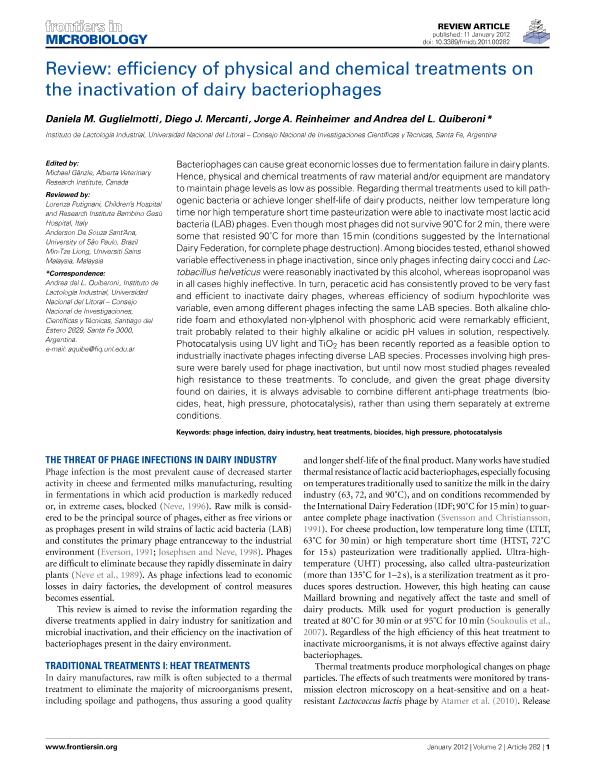Artículo
Review: Efficiency of physical and chemical treatments on the inactivation of dairy bacteriophages
Guglielmotti, Daniela Marta ; Mercanti, Diego Javier
; Mercanti, Diego Javier ; Reinheimer, Jorge Alberto
; Reinheimer, Jorge Alberto ; Quiberoni, Andrea del Lujan
; Quiberoni, Andrea del Lujan
 ; Mercanti, Diego Javier
; Mercanti, Diego Javier ; Reinheimer, Jorge Alberto
; Reinheimer, Jorge Alberto ; Quiberoni, Andrea del Lujan
; Quiberoni, Andrea del Lujan
Fecha de publicación:
01/2012
Editorial:
Frontiers Research Foundation
Revista:
Frontiers in Microbiology
ISSN:
1664-302X
Idioma:
Inglés
Tipo de recurso:
Artículo publicado
Clasificación temática:
Resumen
Bacteriophages can cause great economic losses due to fermentation failure in dairy plants. Hence, physical and chemical treatments of raw material and/or equipment are mandatory to maintain phage levels as low as possible. Regarding thermal treatments used to kill pathogenic bacteria or achieve longer shelf-life of dairy products, neither low temperature long time nor high temperature short time pasteurization were able to inactivate most lactic acid bacteria (LAB) phages. Even though most phages did not survive 90°C for 2 min, there were some that resisted 90°C for more than 15 min (conditions suggested by the International Dairy Federation, for complete phage destruction). Among biocides tested, ethanol showed variable effectiveness in phage inactivation, since only phages infecting dairy cocci and Lac-tobacillus helveticus were reasonably inactivated by this alcohol, whereas isopropanol was in all cases highly ineffective. In turn, peracetic acid has consistently proved to be very fast and efficient to inactivate dairy phages, whereas efficiency of sodium hypochlorite was variable, even among different phages infecting the same LAB species. Both alkaline chloride foam and ethoxylated non-ylphenol with phosphoric acid were remarkably efficient, trait probably related to their highly alkaline or acidic pH values in solution, respectively. Photocatalysis using UV light and TiO2 has been recently reported as a feasible option to industrially inactivate phages infecting diverse LAB species. Processes involving high pressure were barely used for phage inactivation, but until now most studied phages revealed high resistance to these treatments. To conclude, and given the great phage diversity found on dairies, it is always advisable to combine different anti-phage treatments (biocides, heat, high pressure, photocatalysis), rather than using them separately at extreme conditions.
Archivos asociados
Licencia
Identificadores
Colecciones
Articulos(INLAIN)
Articulos de INST.DE LACTOLOGIA INDUSTRIAL
Articulos de INST.DE LACTOLOGIA INDUSTRIAL
Citación
Guglielmotti, Daniela Marta; Mercanti, Diego Javier; Reinheimer, Jorge Alberto; Quiberoni, Andrea del Lujan; Review: Efficiency of physical and chemical treatments on the inactivation of dairy bacteriophages; Frontiers Research Foundation; Frontiers in Microbiology; 2; 282; 1-2012; 1-11
Compartir
Altmétricas



